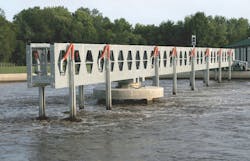Clash of the Titans
Schreiber often encounters questions regarding how its continuously sequencing reactor (CSR) compares to the various sequencing batch reactors (SBR) that are on the market.
Of course, the two systems are similar in that they are both activated sludge processes that produce the oxic, anoxic and anaerobic process phases over time in the same basin. However, there are some very significant and distinctive differences between the two concepts.
Originally, the SBR was designed to handle small flows in locations where it was not possible to build a biological reactor and a clarifier. Basically, the SBR basin is designed to function as a reactor, then as a clarifier and, finally, as a decanter. Following this SBR procedure requires the basin to spend time in five different activities. First, the basin takes time for the influent to fill the basin. Then it functions as a reactor, taking time to move through the oxic, anoxic and anaerobic process phases. Next, more time is required for settling during the clarifier phase before the slowly proceeding decanting process can take place. The last required step in the sequence is the removal of the “to-be-wasted” (WAS) portion of the sludge. Finally, the procedure starts over again with the “filling” step.
The time periods required for each of these procedures to take place produce a fundamental problem for SBRs: intermittent flows. Since the influent flow to a wastewater treatment facility is typically more or less continuous, the batch nature, inherent to the SBR, requires that the outflow be intermittent, or at least highly variable. Obviously, for a single basin SBR, the outflow will experience long periods of zero outflow during the filling, reacting and settling functions. For this arrangement to work in practice, a basin to “hold the inflow” during the batch process must be provided, which adds the significant cost of another basin for holding the inflow to the system.
The “on” and “off” nature of the outflows from SBR facilities create additional problems. Large intermittent outflows can generate costly issues for downstream components, such as filters and UV systems, which must be “upsized” to handle the periods of high flow, followed by long periods of no flow. For a single basin SBR, the peak of the outflow can be 500% of that required for a continuous flow system, such as that of the Schreiber CSR.
One “outflow-smoothing” option often quoted for inclusion in SBR systems is the addition of an equalization (EQ) basin to the outflow end of the process. Again, this requires space, concrete, valves and controls, all of which add more cost and complexity to the system.
Another issue that is often overlooked by SBR proponents is the large number of electromechanical (EM) devices (e.g. decanters, mixers, valves, pumps, etc.) that are required to operate an SBR. EM devices in a wastewater environment can quickly become the source of many operator headaches, as they are subject to a myriad of malfunctions and damages caused by the harsh environment and any number of external events—from physical accidents to electrical outages to human error. Plus, they require persistent and often specialized maintenance. A typical dual-basin SBR will require 16 or more such electromechanical devices. By contrast, the Schreiber CSR process, including clarifier and RAS pumps, will only need six such devices.
One of the biggest advantages of the CSR over SBRs is its ease of operation. The CSR is designed to be operator-friendly, and it handles upset conditions extremely well due to its longer detention times. Conversely, piloting an SBR through upset conditions can confound even an operator’s best efforts.
One operator recently compared his experiences operating an SBR under a siege of mechanical failures to “trying to stack oily BB’s on a glass table.” When just about everything is set for the clarification phase, it’s time to change the setup again to work around a broken decanter or malfunctioning mixer or a stuck valve. Obviously, it can quickly become a nightmare.
Basically, these types of problems are caused by two things: All of the previously mentioned electromechanical devices have to be operated by hand, repaired or bypassed; and, since there is not a separate basin for clarification, the system is unforgiving. The basin must be continually reset to accommodate the next phase. The problems compound as the multitude of EM devices are continuously reset, reactivated or bypassed as the SBR continues to move through its phases of operation.
Contrast that with the fact that, for Schreiber’s CSR, manual operations do not present problems and are, in fact, quite operator-friendly. The bridge can even be “parked” for several days in case of a real emergency, while the operator has only to turn the blowers on and off every several hours as needed.
From a practical standpoint, any SBR facility really needs onsite redundant backup for its process-controlling PLCs. Because of all the electromechanical devices, a PLC failure can quickly escalate into much bigger problems. Conversely, the Schreiber FlexControl system can operate manually without a PLC.
SBRs consume large quantities of energy for mixing, while the CSR maintains mixing with only 2 to 3 hp per mgd on a peripheral drive. Another advantage of this type of CSR gentle mixing is that it is very helpful in maintaining an environment conducive to the functioning of the biological organisms that are performing the real process work in the MLSS.
As a result of Schreiber’s “maintenance without dewatering” equipment, the CSR has been approved for single-train operations all the way up to 3-mgd-sized plants. (Such approval is on a state-by-state and case-by-case basis.) If a user has a problem with an equipment component, such as a diffuser header, he or she can simply retrieve and remove that component and continue operations; SBRs do not have such designed-in redundancy: Unless they are equipped with a costly spare basin or some other type of storage system, they will be out of service.
